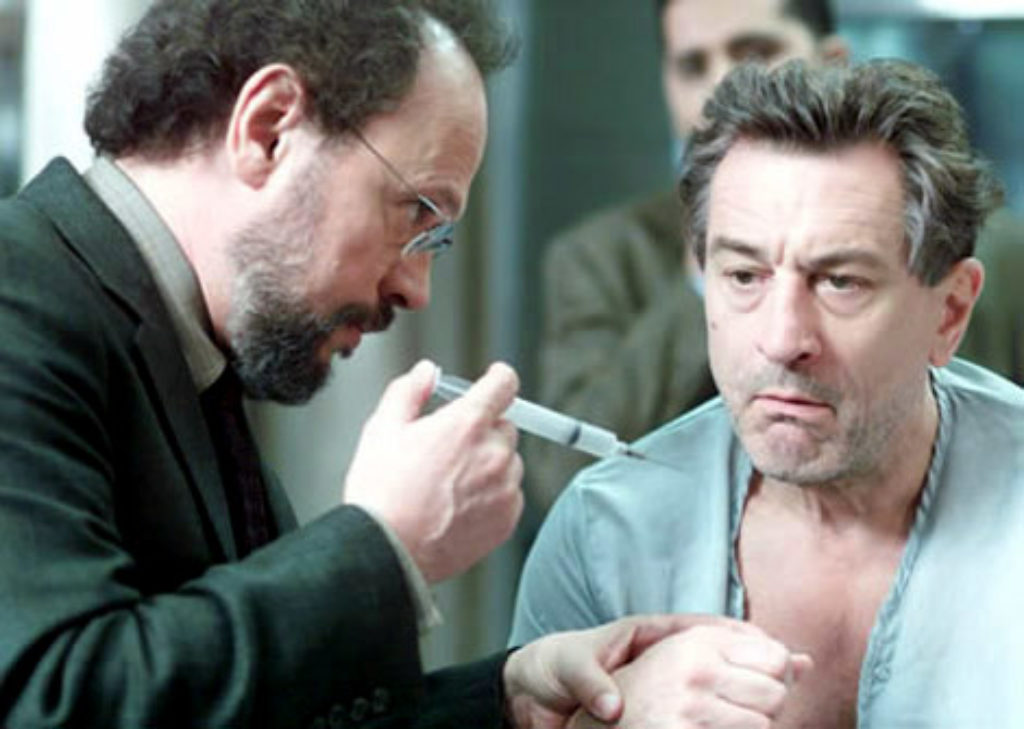
“You think Tony Soprano’s sick? You ain’t seen nothin’ yet.” No, that’s not Plugged In’s clever attempt to steer families away from the new Robert De Niro/Billy Crystal Analyze flick; it’s the studio’s ad copy designed to promote it. It’s no surprise, then, that Analyze That is crueler than Analyze This. In fact, cruelty seems to be the only joke this broken-down follow-up has left.
Mob boss Paul Vitti is about to come up for parole at Sing Sing when another con tries to stick him with a knife in the cafeteria. Paul knocks the guy silly before abruptly breaking into maniacal song. I wrote that right—song. And it’s from West Side Story, no less. In the days that follow, Vitti alternates between catatonia and Broadway fever. That’s when Dr. Sobel is told that Vitti is being released into his custody (the Feds know Sobel served as Vitti’s shrink before he was incarcerated). The pretext is that Sobel has to cure the crazy criminal before his parole hearing scheduled for the next month. The real reason is that they want Vitti back on the street so they can use him to get closer to his Family. Sobel’s as clueless as ever, and falls for both the FBI’s and Vitti’s tricks—much to his new wife, Laura’s, dismay. Vitti immediately begins planning his latest, greatest escapade (an armored car heist) and Sobel tags haplessly along, muttering psycho-babble all the while.
positive elements: What little positivity made it into the first movie has been wholly purged here. The best I can do is say it’s a positive thing that somewhere between This and That, Sobel married his fiancée, Laura.
sexual content: The film opens with a shot of a stripper, wearing panties and a bra, dancing around a pole. Later, Sobel finds Vitti hanging out at a strip club. The camera goes in for close-ups of the dancers, and Sobel finds himself stuffing money into a girl’s panties after she rubs her barely-covered breasts on his face. Vitti’s first night out of jail is spent having sex with an unnamed woman he summons to Sobel’s home. Sobel and his family are forced to listen as the two carry on (loudly) for nearly an hour. Sobel finally interrupts and asks that they stop (“I have a 17-year-old son,” he pleads). But Vitti just cracks a joke about the boy joining them. The woman he’s with is shown wearing a teddy, but none of their activities are seen—just heard. Jokes and gags revolve around the subjects of masturbation (Vitti makes obscene gestures suggesting it), rape, sexual anatomy (Vitti flashes some of Ben’s relatives), prostitution, castration, erections (Vitti spends a great deal of time describing his sexual prowess), homosexuality and impotence.
violent content: De Niro and the Mob. That’s all you need to know. It’s always been a recipe for violence. Several point-blank killings are shown (there’s not a lot of blood). A prison guard tries to kill Vitti by firing multiple shots into his bed. To see if Vitti is pretending to be catatonic, Sobel slaps him and sticks his leg with a needle. Numerous fistfights break out, some of them bloody. Even Sobel punches a guy out, leaving his face battered and bleeding. Machine gun fire lays waste to a restaurant, and it’s also exchanged when police officers tangle with the hijackers. One gangster grabs Sobel’s genitals and squeezes them (his hand is under the table, so only Sobel’s agonized reaction is shown). A man is dangled over a wall to make him talk. Once he does, he’s dropped over the side into a garbage bin. Of course there’s a wild car chase (some of its participants wind up dead). And there’s lots more violence to be had in the climactic armored car heist.
crude or profane language: F-words and s-words are routine and many times dressed up as “comic relief” (there are more than 100). Numerous vulgar anatomical terms are mixed in, as are about 20 abuses of the Lord’s name.
drug and alcohol content: Sobel pops pills throughout the film. He says they are ibuprofen, Echinacea and Ginkgo biloba, but the implication is that he’s self-medicating. At a dinner meeting with Vitti and a television producer, everyone drinks, but Sobel mixes his with whatever drugs he’s taking. He begins drooling and babbling as a result. Wine is drunk on other occasions. In one of Vitti’s fantasies, Sobel is dressed up like Dr. Freud and snorts what looks like cocaine. Miscellaneous characters smoke cigarettes and cigars.
other negative elements: Honest work is demeaned while criminal enterprise respected. People with serious mental disorders are mocked. Sobel fantasizes about cussing out his father at his funeral. There are comments made about killing a spouse and wanting to kill a parent.
conclusion: Anybody raving over this one needs therapy. It’s a paint-by-numbers sequel that relies on puerile punch lines, vulgar language and senseless violence to cover up fall-flat setups, comatose pacing and a vanishing plot. After suffering through Analyze This and Analyze That, here’s hoping we never have to Analyze the Other Thing.
